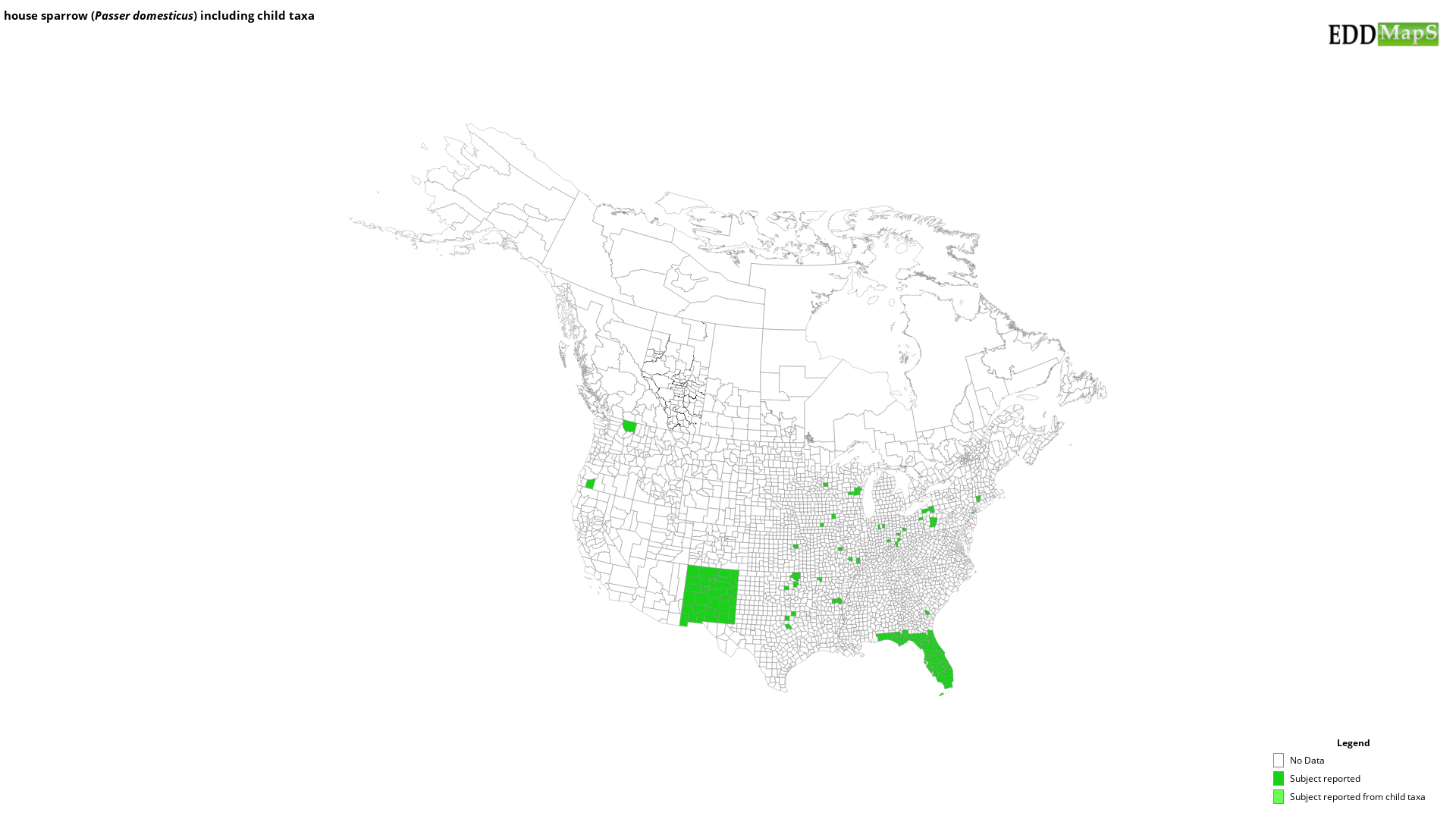house sparrow
(Passer domesticus)
This species is Introduced in the United States
Origin
Passer domesticus is native to Eurasia, North Africa, and the Middle East. House sparrow were initially introduced to the United States in 1851 in Brooklyn, New York because it was a familiar species to European immigrants.
Life Cycle
P. domesticus have stouter bill than the majority of American sparrows with a shorter tail, larger and rounder head, and stockier body. Male plumage is brightly colored with gray heads, white cheeks, a black bib, and rufous neck while females are plainer in plumage. House sparrows live in close proximity to people and our structures. P. domesticus will not be found in extensive grasslands or forests. Nests are found in holes of buildings or other structures and will often displace native avian species at nest boxes. Females lay clutches of 1-8 eggs and the ability to have 1-4 broods in a year. The incubation period for P. domesticus is 10-14 days with another 10-14 for the nestling period.
Distribution
Considered a nuisance to many individuals due to it displacing native avian species, P. domesticus easily became established across North America.
Control Efforts
Placing nest boxes away from human structures and houses will deter P. domesticus from utilizing them. Actively managing nest boxes for migratory native species is the best chance of attracting these desirable species. The removal of house sparrow nests discourages them, however, this method will work best for single nest boxes as P. domesticus will readily displace native species in other boxes. If populations are high, trapping is an acceptable form of management. House sparrows must be humanely killed* and traps must be checked frequently to ensure native species are not accidentally caught.
*P. domesticus is not protected by the Migratory Bird Treaty Act.
http://www.columbia.edu/itc/cerc/danoff-burg/invasion_bio/inv_spp_summ/Passer_domesticus.htm
https://www.allaboutbirds.org/guide/House_Sparrow/lifehistory#conservation
Passer domesticus is native to Eurasia, North Africa, and the Middle East. House sparrow were initially introduced to the United States in 1851 in Brooklyn, New York because it was a familiar species to European immigrants.
Life Cycle
P. domesticus have stouter bill than the majority of American sparrows with a shorter tail, larger and rounder head, and stockier body. Male plumage is brightly colored with gray heads, white cheeks, a black bib, and rufous neck while females are plainer in plumage. House sparrows live in close proximity to people and our structures. P. domesticus will not be found in extensive grasslands or forests. Nests are found in holes of buildings or other structures and will often displace native avian species at nest boxes. Females lay clutches of 1-8 eggs and the ability to have 1-4 broods in a year. The incubation period for P. domesticus is 10-14 days with another 10-14 for the nestling period.
Distribution
Considered a nuisance to many individuals due to it displacing native avian species, P. domesticus easily became established across North America.
Control Efforts
Placing nest boxes away from human structures and houses will deter P. domesticus from utilizing them. Actively managing nest boxes for migratory native species is the best chance of attracting these desirable species. The removal of house sparrow nests discourages them, however, this method will work best for single nest boxes as P. domesticus will readily displace native species in other boxes. If populations are high, trapping is an acceptable form of management. House sparrows must be humanely killed* and traps must be checked frequently to ensure native species are not accidentally caught.
*P. domesticus is not protected by the Migratory Bird Treaty Act.
http://www.columbia.edu/itc/cerc/danoff-burg/invasion_bio/inv_spp_summ/Passer_domesticus.htm
https://www.allaboutbirds.org/guide/House_Sparrow/lifehistory#conservation
Resources
- Global Invasive Species Database - Invasive Species Specialist Group
- Wikipedia - Wikimedia Foundation, Inc
- Animal Diversity Web - University of Michigan Museum of Zoology
- Florida's Introduced Birds - University of Florida
Selected Images
Maps
EDDMapS Distribution - This map is incomplete and is based only on current site and county level reports made by experts, herbaria, and literature. For more information, visit www.eddmaps.org
State Lists - This map identifies those states that have this species on their invasive species list or law.
Invasive Listing Sources
- Apalachicola Invasive Working Group
- Everglades Cooperative Invasive Species Management Area
- Florida Invasive Species Partnership
- Invasive Species of Concern in Georgia
- New Jersey Invasive Species Strike Team 2017 Invasive Species List
- Nonnative Invasive Species in Southern Forest and Grassland Ecosystems
- To be proposed for MISC
Taxonomic Rank
| Domain: Eukarya |
| Kingdom: Animalia |
| Phylum: Chordata |
| Class: Aves |
| Order: Passeriformes |
| Family: Passeridae |
| Genus: Passer |
| Passer domesticus |
References
Common Name Reference: Integrated Taxonomic Information System on-line database.
Scientific Name Reference: Integrated Taxonomic Information System on-line database.


